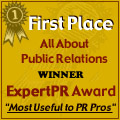|
by Robert
A. Kelly
Without
a solid, well-designed foundation,
few buildings successfully
withstand the ravages of time and
weather. And so it is with public
relations, ever-dependent upon how
well its practitioners understand
the discipline.
Yet, some public relations people
manage to go through their entire
career without a firm grasp of
what public relations is all
about. Their response to crises,
or to requests for well
thought-out solutions to public
relations problems, reveals a
serious lack of understanding.
They confuse the basic function of
public relations with any number
of tactical parts that make up the
whole, such as publicity, crisis
management or employee relations.
Understandably, they feel unsure
in approaching public relations
problems, then uncertain about
what counsel to give their
clients. Many, relying on
career-long misconceptions about
public relations, forge ahead
anyway advising the client
ineffectively sometimes with
damaging, if not dangerous
counsel.
If you undertake a public
relations career, you can take
steps to avoid this sad waste of
your talent by discussing public
relations' strategic role in any
organization with professionals
whom you respect. But do it early,
do it seriously, and do it now so
that you create that solid
foundation of understanding about
this business that will help you
make a meaningful contribution to
the field of public relations for
many years to come.
My core belief about the basic
function of public relations has
allowed me to feel right over the
years about my assessment of
public relations problems and
opportunities and about the
counsel I give the client. It also
provides the tools I need to
defend that advice if necessary.
In my experience, the key question
about that central function was,
and still is "What do both
internal and external clients want
from us?" I believe they want
us to apply our special skills in
a way that helps them achieve
their business objectives. But no
matter what strategic plan we
create to solve a problem, no
matter what tactical program we
put in place, at the end of the
day the public relations
professional must modify
somebody's behavior if we are to
earn our money.
That's
right, modify somebody's behavior.
But, on the way we must do
everything necessary to reach our
target audiences, and to nurture
the relationships between those
audiences and the client's
business by burnishing the
reputation of the company, its
products and services. We'll do
our best to persuade those
audiences to do what the client
wishes them to do. And, while
seeking public understanding and
acceptance of our client, we'll
insure that our joint activities
not only comply with the law, but
clearly serve the public interest.
Then, we'll pull-out all tactical
stops in the effort to
actually move those individuals to
action. Our client will be pleased
that we have brought matters to
this point.
But, when that client measures our
real effectiveness, I suggest that
he or she will be fully satisfied
with those public relations
results only when our "reach,
persuade and move-to-action"
strategy produces a visible, and
desired, modification in the
behaviors of those people our
client wishes to influence. In my
view, here is the central,
strategic function of public
relations - the basic context in
which we must operate - and one
that is best learned at the
beginning of your career.
PR
consultant Bob Kelly was
director of PR for Pepsi-Cola
Co.; AGM-PR, Texaco Inc.; VP-PR,
Olin Corp.; VP-PR, Newport News
Shipbuilding; director of
communications, U.S. Department
of the Interior, and deputy
assistant press secretary, The
White House.
bobkelly@TNI.net
More
Articles | Submit
Your Article | PR
Subjects
About
Public Relations Homepage
Contact Us
|



